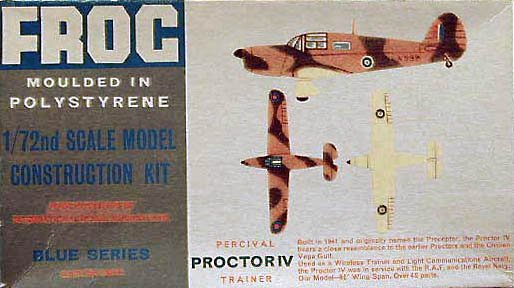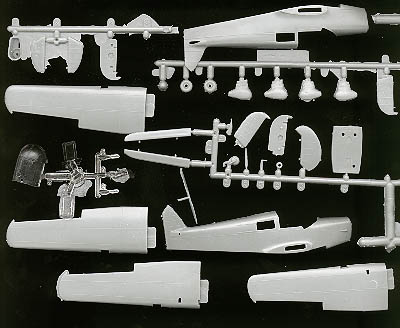
|
KIT: |
Frog/Novo 1/72 Percival Proctor IV |
|
KIT # |
F 341 |
|
PRICE: |
OOP |
|
DECALS: |
none included |
|
REVIEWER: |
Kim Elliot |
|
NOTES: |

|
HISTORY |
The Percival Proctor was the military version of the civil Vega Gull low-wing, single engine sport and touring aircraft, which first flew in 1935. The first military version, the Proctor I, flew in October, 1938. It had a fixed, spatted undercarriage, a plywood and fabric structure, a 210 h.p. de Havilland Gypsy Queen engine, and an AUW of 3,500 lb.. Wingspan is 39’ 6”, length 28’ 2”. The wings folded for storage..
The R.A.F. received 245 of this three-seat communications aircraft. The Proctor II, externally similar, was a radio-operator trainer without dual control. 50 of these went to the R.A.F.. A further 437 Proctor III were received, differing in minor details. With a lengthened fuselage, a larger cabin seating four, carrying operational radio gear with a D/F loop in a dorsal fairing, the Proctor IV also served in a communications capacity with dual control. 250 were produced. No. 31 Communications Flight continued to use this model until 1955. In addition, the Fleet Air Arm equipt 10 second-line squadrons with Mk. IA and IIA Proctors for the training of W/T Operators during the war. Many surplus Proctors were sold post-war for civil use; some are still flying today.
|
THE KIT |

This kit was first produced by Frog in 1963. It has since been marketed by Novo, and possibly other ex-Soviet enterprises. It had also been reboxed by Airlines for US distribution. The review version came with Novo instructions, which are a straight copy of the original Frog 8-step exploded illustrations. No decals came with the kit, but except for serials, the majority of the aircraft in military service wore only national markings, so replacement with generic roundels is not a problem. Civil versions were generally more colourful, and give the modeller some scope for improvisation. The mouldings are in grey, slightly brittle polystyrene, 42 parts, and include 6 clear transparencies, with three miniature aircrew. The transparencies are poor, and will require polishing and coating in Future, or replacing with vacu-forms (available from Falcon). A bit of flash is to be found, and will require some work with sandpaper and a fine file. Dry fitting of major components indicates no problems. Control surfaces are separate; what surface detail there is is raised. Curiously, although it is listed as a four seater Mk. IV, with the larger rear windows, only three seats are provided. This, and the cockpit floor, are the only interior details. Details of contemporary civil versions can be found on the web for those wishing to add detail to this area. No stand is provided, although the original Frog version had one included. No resin, no photo-etch, minimal detail, this is a basic stripped-down, 1960’s injection moulded model kit. Skill level required is basic, and could be a good starter kit or a weekend wonder, unless one was going for up-grades or detailing. If finished as a military version, colours are limited to brown and green uppers, and yellow undersurface, illustrated in the instructions.
|
REFERENCES |
Not exactly thick on the ground, general arrangement drawings are available from Aviation News and other British sources. The ones I have show the outline as accurate, both in shape and scale size. Putnam’s RAF Aircraft has a small section with G/A drawings. A search on the web will give many historical reference photos, and a good number of current flying and museum civil versions.
If you would like your product reviewed fairly and quickly by a site that has over 250,000 visitors a month, please contact me or see other details in the Note to Contributors.